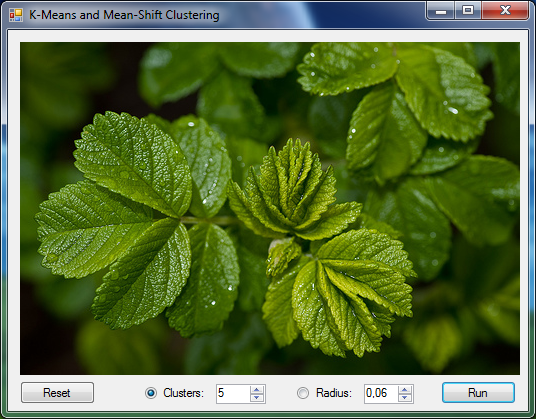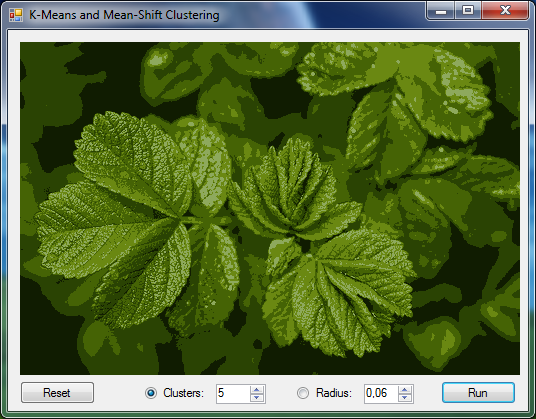|
|
KMeans Class |
Accord.MachineLearningParallelLearningBase
Accord.MachineLearningKMeans
Accord.MachineLearningBalancedKMeans
Accord.MachineLearningBinarySplit
Accord.MachineLearningMiniBatchKMeans
Namespace: Accord.MachineLearning
Assembly: Accord.MachineLearning (in Accord.MachineLearning.dll) Version: 3.8.0
[SerializableAttribute] public class KMeans : ParallelLearningBase, IUnsupervisedLearning<KMeansClusterCollection, double[], int>, IClusteringAlgorithm<double[], double>, IClusteringAlgorithm<double[]>, IUnsupervisedLearning<IClusterCollection<double[]>, double[], int>
The KMeans type exposes the following members.
| Name | Description | |
|---|---|---|
| KMeans(Int32) |
Initializes a new instance of the K-Means algorithm
| |
| KMeans(Int32, IDistanceDouble) |
Initializes a new instance of the KMeans algorithm
| |
| KMeans(Int32, FuncDouble, Double, Double) | Obsolete.
Initializes a new instance of KMeans algorithm
|
| Name | Description | |
|---|---|---|
| Centroids |
Gets or sets the cluster centroids.
| |
| Clusters |
Gets the clusters found by K-means.
| |
| ComputeCovariances |
Gets or sets whether covariance matrices for the clusters should
be computed at the end of an iteration. Default is true.
| |
| ComputeError |
Gets or sets whether the clustering distortion error (the
average distance between all data points and the cluster
centroids) should be computed at the end of the algorithm.
The result will be stored in Error. Default is true.
| |
| Dimension |
Gets the dimensionality of the data space.
| |
| Distance |
Gets or sets the distance function used
as a distance metric between data points.
| |
| Error |
Gets the cluster distortion error after the
last call to this class' Compute methods.
| |
| Iterations |
Gets the number of iterations performed in the
last call to this class' Compute methods.
| |
| K |
Gets the number of clusters.
| |
| MaxIterations |
Gets or sets the maximum number of iterations to
be performed by the method. If set to zero, no
iteration limit will be imposed. Default is 0.
| |
| ParallelOptions |
Gets or sets the parallelization options for this algorithm.
(Inherited from ParallelLearningBase.) | |
| Token |
Gets or sets a cancellation token that can be used
to cancel the algorithm while it is running.
(Inherited from ParallelLearningBase.) | |
| Tolerance |
Gets or sets the relative convergence threshold
for stopping the algorithm. Default is 1e-5.
| |
| UseSeeding |
Gets or sets the strategy used to initialize the
centroids of the clustering algorithm. Default is
KMeansPlusPlus.
|
| Name | Description | |
|---|---|---|
| Compute(Double) | Obsolete.
Divides the input data into K clusters.
| |
| Compute(Double, Double) | Obsolete.
Divides the input data into K clusters.
| |
| Compute(Double, Double) | Obsolete.
Divides the input data into K clusters.
| |
| ComputeInformation(Double) |
Computes the information about each cluster (covariance, proportions and error).
| |
| ComputeInformation(Double, Int32) |
Computes the information about each cluster (covariance, proportions and error).
| |
| converged |
Determines if the algorithm has converged by comparing the
centroids between two consecutive iterations.
| |
| Equals | Determines whether the specified object is equal to the current object. (Inherited from Object.) | |
| Finalize | Allows an object to try to free resources and perform other cleanup operations before it is reclaimed by garbage collection. (Inherited from Object.) | |
| GetHashCode | Serves as the default hash function. (Inherited from Object.) | |
| GetType | Gets the Type of the current instance. (Inherited from Object.) | |
| Learn |
Learns a model that can map the given inputs to the desired outputs.
| |
| MemberwiseClone | Creates a shallow copy of the current Object. (Inherited from Object.) | |
| Randomize |
Randomizes the clusters inside a dataset.
| |
| ToString | Returns a string that represents the current object. (Inherited from Object.) |
| Name | Description | |
|---|---|---|
| HasMethod |
Checks whether an object implements a method with the given name.
(Defined by ExtensionMethods.) | |
| IsEqual |
Compares two objects for equality, performing an elementwise
comparison if the elements are vectors or matrices.
(Defined by Matrix.) | |
| To(Type) | Overloaded.
Converts an object into another type, irrespective of whether
the conversion can be done at compile time or not. This can be
used to convert generic types to numeric types during runtime.
(Defined by ExtensionMethods.) | |
| ToT | Overloaded.
Converts an object into another type, irrespective of whether
the conversion can be done at compile time or not. This can be
used to convert generic types to numeric types during runtime.
(Defined by ExtensionMethods.) |
In statistics and machine learning, k-means clustering is a method of cluster analysis which aims to partition n observations into k clusters in which each observation belongs to the cluster with the nearest mean.
It is similar to the expectation-maximization algorithm for mixtures of Gaussians in that they both attempt to find the centers of natural clusters in the data as well as in the iterative refinement approach employed by both algorithms.
The algorithm is composed of the following steps:
- Place K points into the space represented by the objects that are being clustered. These points represent initial group centroids.
- Assign each object to the group that has the closest centroid.
- When all objects have been assigned, recalculate the positions of the K centroids.
- Repeat Steps 2 and 3 until the centroids no longer move. This produces a separation of the objects into groups from which the metric to be minimized can be calculated.
This particular implementation uses the squared Euclidean distance as a similarity measure in order to form clusters.
References:
- Wikipedia, The Free Encyclopedia. K-means clustering. Available on: http://en.wikipedia.org/wiki/K-means_clustering
- Matteo Matteucci. A Tutorial on Clustering Algorithms. Available on: http://home.dei.polimi.it/matteucc/Clustering/tutorial_html/kmeans.html
How to perform clustering with K-Means.
Accord.Math.Random.Generator.Seed = 0; // Declare some observations double[][] observations = { new double[] { -5, -2, -1 }, new double[] { -5, -5, -6 }, new double[] { 2, 1, 1 }, new double[] { 1, 1, 2 }, new double[] { 1, 2, 2 }, new double[] { 3, 1, 2 }, new double[] { 11, 5, 4 }, new double[] { 15, 5, 6 }, new double[] { 10, 5, 6 }, }; // Create a new K-Means algorithm KMeans kmeans = new KMeans(k: 3); // Compute and retrieve the data centroids var clusters = kmeans.Learn(observations); // Use the centroids to parition all the data int[] labels = clusters.Decide(observations);
How to perform clustering with K-Means applying different weights to different columns (dimensions) in the data.
Accord.Math.Random.Generator.Seed = 0; // A common desire when doing clustering is to attempt to find how to // weight the different components / columns of a dataset, giving them // different importances depending on the end goal of the clustering task. // Declare some observations double[][] observations = { new double[] { -5, -2, -1 }, new double[] { -5, -5, -6 }, new double[] { 2, 1, 1 }, new double[] { 1, 1, 2 }, new double[] { 1, 2, 2 }, new double[] { 3, 1, 2 }, new double[] { 11, 5, 4 }, new double[] { 15, 5, 6 }, new double[] { 10, 5, 6 }, }; // Create a new K-Means algorithm KMeans kmeans = new KMeans(k: 3) { // For example, let's say we would like to consider the importance of // the first column as 0.1, the second column as 0.7 and the third 0.9 Distance = new WeightedSquareEuclidean(new double[] { 0.1, 0.7, 1.1 }) }; // Compute and retrieve the data centroids var clusters = kmeans.Learn(observations); // Use the centroids to parition all the data int[] labels = clusters.Decide(observations);
How to perform clustering with K-Means with mixed discrete, continuous and categorical data.
Accord.Math.Random.Generator.Seed = 0; // Declare some mixed discrete and continuous observations double[][] observations = { // (categorical) (discrete) (continuous) new double[] { 1, -1, -2.2 }, new double[] { 1, -6, -5.5 }, new double[] { 2, 1, 1.1 }, new double[] { 2, 2, 1.2 }, new double[] { 2, 2, 2.6 }, new double[] { 3, 2, 1.4 }, new double[] { 3, 4, 5.2 }, new double[] { 1, 6, 5.1 }, new double[] { 1, 6, 5.9 }, }; // Create a new codification algorithm to convert // the mixed variables above into all continuous: var codification = new Codification<double>() { CodificationVariable.Categorical, CodificationVariable.Discrete, CodificationVariable.Continuous }; // Learn the codification from observations var model = codification.Learn(observations); // Transform the mixed observations into only continuous: double[][] newObservations = model.ToDouble().Transform(observations); // (newObservations will be equivalent to) double[][] expected = { // (one hot) (discrete) (continuous) new double[] { 1, 0, 0, -1, -2.2 }, new double[] { 1, 0, 0, -6, -5.5 }, new double[] { 0, 1, 0, 1, 1.1 }, new double[] { 0, 1, 0, 2, 1.2 }, new double[] { 0, 1, 0, 2, 2.6 }, new double[] { 0, 0, 1, 2, 1.4 }, new double[] { 0, 0, 1, 4, 5.2 }, new double[] { 1, 0, 0, 6, 5.1 }, new double[] { 1, 0, 0, 6, 5.9 }, }; // Create a new K-Means algorithm KMeans kmeans = new KMeans(k: 3); // Compute and retrieve the data centroids var clusters = kmeans.Learn(observations); // Use the centroids to parition all the data int[] labels = clusters.Decide(observations);
The following example demonstrates how to use the K-Means algorithm for color clustering. It is the same code which can be found in the color clustering sample application.
// Load a test image (shown in a picture box below) var sampleImages = new TestImages(path: basePath); Bitmap image = sampleImages.GetImage("airplane.png"); // ImageBox.Show("Original", image).Hold(); // Create converters to convert between Bitmap images and double[] arrays var imageToArray = new ImageToArray(min: -1, max: +1); var arrayToImage = new ArrayToImage(image.Width, image.Height, min: -1, max: +1); // Transform the image into an array of pixel values double[][] pixels; imageToArray.Convert(image, out pixels); // Create a K-Means algorithm using given k and a // square Euclidean distance as distance metric. KMeans kmeans = new KMeans(k: 5) { Distance = new SquareEuclidean(), // We will compute the K-Means algorithm until cluster centroids // change less than 0.5 between two iterations of the algorithm Tolerance = 0.05 }; // Learn the clusters from the data var clusters = kmeans.Learn(pixels); // Use clusters to decide class labels int[] labels = clusters.Decide(pixels); // Replace every pixel with its corresponding centroid double[][] replaced = pixels.Apply((x, i) => clusters.Centroids[labels[i]]); // Retrieve the resulting image (shown in a picture box) Bitmap result; arrayToImage.Convert(replaced, out result); // ImageBox.Show("k-Means clustering", result).Hold();
The original image is shown below:

The resulting image will be:
